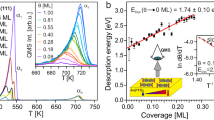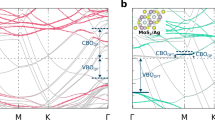Abstract
Van der Waals (vdW) interaction, and its subtle interplay with chemically specific interactions and surface roughness at metal/organic interfaces, is critical to the understanding of structure–function relations in diverse areas, including catalysis, molecular electronics and self-assembly1,2,3. However, vdW interactions remain challenging to characterize directly at the fundamental, single-molecule level both in experiments and in first principles calculations with accurate treatment of the non-local, London dispersion interactions. In particular, for metal/organic interfaces, efforts so far have largely focused on model systems consisting of adsorbed molecules on flat metallic surfaces with minimal specific chemical interaction4,5,6,7,8,9. Here we show, through measurements of single-molecule mechanics, that pyridine derivatives10,11 can bind to nanostructured Au electrodes through an additional binding mechanism beyond the chemically specific N–Au donor–acceptor bond. Using density functional theory simulations we show that vdW interactions between the pyridine ring and Au electrodes can play a key role in the junction mechanics. These measurements thus provide a quantitative characterization of vdW interactions at metal/organic interfaces at the single-molecule level.
This is a preview of subscription content, access via your institution
Access options
Subscribe to this journal
Receive 12 print issues and online access
$259.00 per year
only $21.58 per issue
Buy this article
- Purchase on Springer Link
- Instant access to full article PDF
Prices may be subject to local taxes which are calculated during checkout




Similar content being viewed by others
References
Norskov, J. K., Bligaard, T., Rossmeisl, J. & Christensen, C. H. Towards the computational design of solid catalysts. Nature Chem. 1, 37–46 (2009).
Moth-Poulsen, K. & Bjornholm, T. Molecular electronics with single molecules in solid-state devices. Nature Nanotech. 4, 551–556 (2009).
Bartels, L. Tailoring molecular layers at metal surfaces. Nature Chem. 2, 87–95 (2010).
Cunha, F. et al. Potential-induced phase transitions in 2,2’-bipyridine and 4,4’-bipyridine monolayers on Au(111) studied by in situ scanning tunneling microscopy and atomic force microscopy. Langmuir 12, 6410–6418 (1996).
Wandlowski, T., Ataka, K. & Mayer, D. In situ infrared study of 4,4 ’-bipyridine adsorption on thin gold films. Langmuir 18, 4331–4341 (2002).
Mercurio, G. et al. Structure and energetics of Azobenzene on Ag(111): Benchmarking semiempirical dispersion correction approaches. Phys. Rev. Lett. 104, 036102 (2010).
Tonigold, K. & Gross, A. Adsorption of small aromatic molecules on the (111) surfaces of noble metals: A density functional theory study with semiempirical corrections for dispersion effects. J. Chem. Phys. 132, 224701 (2010).
Ruiz, V. G., Liu, W., Zojer, E., Scheffler, M. & Tkatchenko, A. Density-functional theory with screened van der Waals interactions for the modeling of hybrid inorganic–organic systems. Phys. Rev. Lett. 108, 146103 (2012).
Li, G., Tamblyn, I., Cooper, V. R., Gao, H-J. & Neaton, J. B. Molecular adsorption on metal surfaces with van der Waals density functionals. Phys. Rev. B 85, 121409 (2012).
Tam, E. S. et al. Single-molecule conductance of pyridine-terminated dithienylethene switch molecules. ACS Nano 5, 5115–5123 (2011).
Quek, S. Y. et al. Mechanically controlled binary conductance switching of a single-molecule junction. Nature Nanotech. 4, 230–234 (2009).
Hong, W. et al. Single molecular conductance of tolanes: Experimental and theoretical study on the junction evolution dependent on the anchoring group. J. Am. Chem. Soc. 134, 2292–2304 (2011).
Rubio-Bollinger, G., Bahn, S. R., Agrait, N., Jacobsen, K. W. & Vieira, S. Mechanical properties and formation mechanisms of a wire of single gold atoms. Phys. Rev. Lett. 87, 026101 (2001).
Frei, M., Aradhya, S. V., Koentopp, M., Hybertsen, M. S. & Venkataraman, L. Mechanics and chemistry: Single molecule bond rupture forces correlate with molecular backbone structure. Nano Lett. 11, 1518–1523 (2011).
Sorensen, M. R., Brandbyge, M. & Jacobsen, K. W. Mechanical deformation of atomic-scale metallic contacts: Structure and mechanisms. Phys. Rev. B 57, 3283–3294 (1998).
Stadler, R., Thygesen, K. & Jacobsen, K. Forces and conductances in a single-molecule bipyridine junction. Phys. Rev. B 72, 241401 (2005).
Huang, Z. F., Xu, B. Q., Chen, Y. C., Di Ventra, M. & Tao, N. J. Measurement of current-induced local heating in a single molecule junction. Nano Lett. 6, 1240–1244 (2006).
Tsutsui, M., Taniguchi, M. & Kawai, T. Atomistic mechanics and formation mechanism of metal-molecule-metal junctions. Nano Lett. 9, 2433–2439 (2009).
Kamenetska, M. et al. Conductance and geometry of pyridine-linked single-molecule junctions. J. Am. Chem. Soc. 132, 6817–6821 (2010).
Xu, B. Q., Xiao, X. Y. & Tao, N. J. Measurements of single-molecule electromechanical properties. J. Am. Chem. Soc. 125, 16164–16165 (2003).
Yanson, A. I., Bollinger, G. R., van den Brom, H. E., Agrait, N. & van Ruitenbeek, J. M. Formation and manipulation of a metallic wire of single gold atoms. Nature 395, 783–785 (1998).
Meisner, J. S. et al. A single-molecule potentiometer. Nano Lett. 11, 1575–1579 (2011).
Ohnishi, H., Kondo, Y. & Takayanagi, K. Quantized conductance through individual rows of suspended gold atoms. Nature 395, 780–783 (1998).
Grimme, S. Semiempirical GGA-type density functional constructed with a long-range dispersion correction. J. Comput. Chem. 27, 1787–1799 (2006).
Bilic, A., Reimers, J. R. & Hush, N. S. Adsorption of pyridine on the gold(111) surface: Implications for ‘alligator clips’ for molecular wires. J. Phys. Chem. B 106, 6740–6747 (2002).
Schneebeli, S. T. et al. Single-molecule conductance through multiple π–π-stacked benzene rings determined with direct electrode-to-benzene ring connections. J. Am. Chem. Soc. 133, 2136–2139 (2011).
Perdew, J. P., Burke, K. & Ernzerhof, M. Generalized gradient approximation made simple. Phys. Rev. Lett. 77, 3865–3868 (1996).
Kresse, G. & Furthmuller, J. Efficient iterative schemes for ab initio total-energy calculations using a plane-wave basis set. Phys. Rev. B 54, 11169 (1996).
Sławińska, J., Dabrowski, P. & Zasada, I. Doping of graphene by a Au(111) substrate: Calculation strategy within the local density approximation and a semiempirical van der Waals approach. Phys. Rev. B 83, 245429 (2011).
Kelkkanen, A. K., Lundqvist, B. I. & Norskov, J. K. Van der Waals effect in weak adsorption affecting trends in adsorption, reactivity, and the view of substrate nobility. Phys. Rev. B 83, 113401 (2011).
Acknowledgements
This work was supported by the National Science Foundation (Career CHE-07-44185) and by the Packard Foundation. A portion of this work was performed using facilities in the Center for Functional Nanomaterials at Brookhaven National Laboratory and supported by the US Department of Energy, Office of Basic Energy Sciences, under contract number DE-AC02-98CH10886 (M.S.H.). L.V. acknowledges support from the NSF DMR-1122594.
Author information
Authors and Affiliations
Contributions
Experiments were conceived by S.V.A. and L.V. and performed by S.V.A. and M.F. All calculations were performed by M.S.H. Data analysis was done by S.V.A., who co-wrote the paper with M.S.H. and L.V.
Corresponding authors
Ethics declarations
Competing interests
The authors declare no competing financial interests.
Supplementary information
Supplementary Information
Supplementary Information (PDF 1679 kb)
Rights and permissions
About this article
Cite this article
Aradhya, S., Frei, M., Hybertsen, M. et al. Van der Waals interactions at metal/organic interfaces at the single-molecule level. Nature Mater 11, 872–876 (2012). https://doi.org/10.1038/nmat3403
Received:
Accepted:
Published:
Issue Date:
DOI: https://doi.org/10.1038/nmat3403
This article is cited by
-
Plasmonic phenomena in molecular junctions: principles and applications
Nature Reviews Chemistry (2022)
-
Single-molecule junction spontaneously restored by DNA zipper
Nature Communications (2021)
-
From molecular to supramolecular electronics
Nature Reviews Materials (2021)
-
A single-molecule van der Waals compass
Nature (2021)
-
Sub-nanometer supramolecular rectifier based on the symmetric building block with destructive σ-interference
Science China Chemistry (2021)



